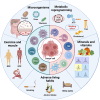The war between the immune system and the tumor - using immune biomarkers as tracers
- PMID: 38816871
- PMCID: PMC11137916
- DOI: 10.1186/s40364-024-00599-5
The war between the immune system and the tumor - using immune biomarkers as tracers
Abstract
Nowadays, immunotherapy is one of the most promising anti-tumor therapeutic strategy. Specifically, immune-related targets can be used to predict the efficacy and side effects of immunotherapy and monitor the tumor immune response. In the past few decades, increasing numbers of novel immune biomarkers have been found to participate in certain links of the tumor immunity to contribute to the formation of immunosuppression and have entered clinical trials. Here, we systematically reviewed the oncogenesis and progression of cancer in the view of anti-tumor immunity, particularly in terms of tumor antigen expression (related to tumor immunogenicity) and tumor innate immunity to complement the cancer-immune cycle. From the perspective of integrated management of chronic cancer, we also appraised emerging factors affecting tumor immunity (including metabolic, microbial, and exercise-related markers). We finally summarized the clinical studies and applications based on immune biomarkers. Overall, immune biomarkers participate in promoting the development of more precise and individualized immunotherapy by predicting, monitoring, and regulating tumor immune response. Therefore, targeting immune biomarkers may lead to the development of innovative clinical applications.
Keywords: Cancer; Immune biomarker; Immunotherapy; Tumor immunity.
© 2024. The Author(s).
Conflict of interest statement
The authors declare no competing interests.
Figures





Similar articles
-
Immune Dysfunctions and Immune-Based Therapeutic Interventions in Chronic Lymphocytic Leukemia.Front Immunol. 2020 Nov 18;11:594556. doi: 10.3389/fimmu.2020.594556. eCollection 2020. Front Immunol. 2020. PMID: 33312177 Free PMC article. Review.
-
The Mechanism of Stimulating and Mobilizing the Immune System Enhancing the Anti-Tumor Immunity.Front Immunol. 2021 Jun 10;12:682435. doi: 10.3389/fimmu.2021.682435. eCollection 2021. Front Immunol. 2021. PMID: 34194437 Free PMC article. Review.
-
Future perspectives in melanoma research : Meeting report from the "Melanoma Bridge". Napoli, December 1st-4th 2015.J Transl Med. 2016 Nov 15;14(1):313. doi: 10.1186/s12967-016-1070-y. J Transl Med. 2016. PMID: 27846884 Free PMC article.
-
Tumor matrix remodeling and novel immunotherapies: the promise of matrix-derived immune biomarkers.J Immunother Cancer. 2018 Jul 3;6(1):65. doi: 10.1186/s40425-018-0376-0. J Immunother Cancer. 2018. PMID: 29970158 Free PMC article. Review.
-
Regulation of cancer-immunity cycle and tumor microenvironment by nanobiomaterials to enhance tumor immunotherapy.Wiley Interdiscip Rev Nanomed Nanobiotechnol. 2020 Jul;12(4):e1612. doi: 10.1002/wnan.1612. Epub 2020 Mar 1. Wiley Interdiscip Rev Nanomed Nanobiotechnol. 2020. PMID: 32114718 Review.
Cited by
-
Ultra-low dose immunoPET using 64Cu-rituximab tracer for a human CD20 mouse model.Front Med (Lausanne). 2025 Apr 7;12:1548132. doi: 10.3389/fmed.2025.1548132. eCollection 2025. Front Med (Lausanne). 2025. PMID: 40259986 Free PMC article.
-
Resveratrol in oral cancer: a systematic review of preclinical studies on its anticancer mechanisms and therapeutic potential.Med Oncol. 2025 Jul 13;42(8):329. doi: 10.1007/s12032-025-02903-1. Med Oncol. 2025. PMID: 40653555
-
Observation on the Therapeutic Efficacy of Camrelizumab Combined with Chemotherapy in Non-small Cell Lung Cancer and the Cutaneous Immune-related Adverse Events: A Retrospective Study.Anticancer Agents Med Chem. 2025;25(8):574-587. doi: 10.2174/0118715206350978241105080452. Anticancer Agents Med Chem. 2025. PMID: 39781731
-
Some Glycoproteins Expressed on the Surface of Immune Cells and Cytokine Plasma Levels Can Be Used as Potential Biomarkers in Patients with Colorectal Cancer.Biomolecules. 2024 Oct 16;14(10):1314. doi: 10.3390/biom14101314. Biomolecules. 2024. PMID: 39456247 Free PMC article.
-
Hydrogels as advanced drug delivery platforms for cancer immunotherapy: promising innovations and future outlook.J Nanobiotechnology. 2025 Jul 28;23(1):545. doi: 10.1186/s12951-025-03613-6. J Nanobiotechnology. 2025. PMID: 40717098 Free PMC article. Review.
References
Publication types
Grants and funding
- 81972484, 82272667/National Natural Science Foundation of China grants
- 81972484, 82272667/National Natural Science Foundation of China grants
- 81972484, 82272667/National Natural Science Foundation of China grants
- 81972484, 82272667/National Natural Science Foundation of China grants
- 81972484, 82272667/National Natural Science Foundation of China grants
- 81972484, 82272667/National Natural Science Foundation of China grants
- 81972484, 82272667/National Natural Science Foundation of China grants
- 81972484, 82272667/National Natural Science Foundation of China grants
- 81972484, 82272667/National Natural Science Foundation of China grants
- JX102GSP201727/High-level Innovation Team of Nanjing Medical University Program
- JX102GSP201727/High-level Innovation Team of Nanjing Medical University Program
- JX102GSP201727/High-level Innovation Team of Nanjing Medical University Program
- JX102GSP201727/High-level Innovation Team of Nanjing Medical University Program
- JX102GSP201727/High-level Innovation Team of Nanjing Medical University Program
- JX102GSP201727/High-level Innovation Team of Nanjing Medical University Program
- JX102GSP201727/High-level Innovation Team of Nanjing Medical University Program
- JX102GSP201727/High-level Innovation Team of Nanjing Medical University Program
- JX102GSP201727/High-level Innovation Team of Nanjing Medical University Program
- JX21817902/008/The Collaborative Innovation Center for Tumor Individualization Program
- JX21817902/008/The Collaborative Innovation Center for Tumor Individualization Program
- JX21817902/008/The Collaborative Innovation Center for Tumor Individualization Program
- JX21817902/008/The Collaborative Innovation Center for Tumor Individualization Program
- JX21817902/008/The Collaborative Innovation Center for Tumor Individualization Program
- JX21817902/008/The Collaborative Innovation Center for Tumor Individualization Program
- JX21817902/008/The Collaborative Innovation Center for Tumor Individualization Program
- JX21817902/008/The Collaborative Innovation Center for Tumor Individualization Program
- JX21817902/008/The Collaborative Innovation Center for Tumor Individualization Program
- Y-2019AZZD-00680/Beijing Xisike Clinical Oncology Research Foundation
- Y-2019AZZD-00680/Beijing Xisike Clinical Oncology Research Foundation
- Y-2019AZZD-00680/Beijing Xisike Clinical Oncology Research Foundation
- Y-2019AZZD-00680/Beijing Xisike Clinical Oncology Research Foundation
- Y-2019AZZD-00680/Beijing Xisike Clinical Oncology Research Foundation
- Y-2019AZZD-00680/Beijing Xisike Clinical Oncology Research Foundation
- Y-2019AZZD-00680/Beijing Xisike Clinical Oncology Research Foundation
- Y-2019AZZD-00680/Beijing Xisike Clinical Oncology Research Foundation
- Y-2019AZZD-00680/Beijing Xisike Clinical Oncology Research Foundation
LinkOut - more resources
Full Text Sources
Miscellaneous

